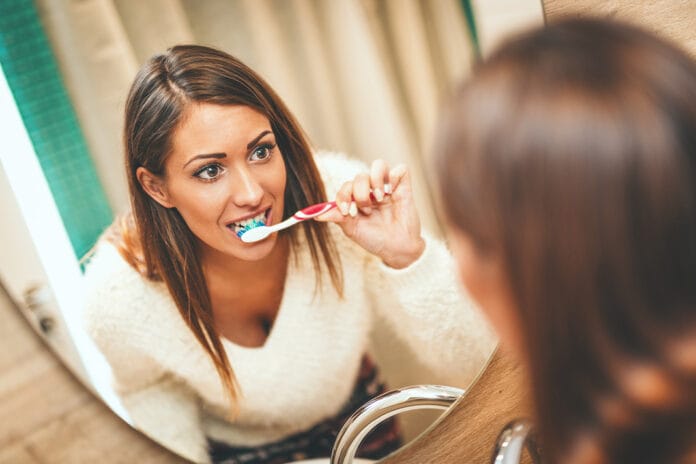For most patients, home-care tips go a long way in preventing diseases in the mouth. The physical, mechanical removal of plaque and bacteria is important to promote for oral health, and it also lays the foundation for promoting overall health.
Brushing, cleaning interdentally, and rinsing are the backbone of hygiene education. If our patients implemented these three things into their daily lives, many issues would be prevented or resolved, including gingivitis, periodontitis, and decay.
But we already know that.
We also already know that a disease process that affects the mouth affects the entire body. Hygienists are some of the only health-care professionals consistently bridging the gap between overall systemic health and the health in our patients’ mouths.
Adequate management of periodontal diseases requires clinicians to not only address the obvious cause of inflammation and disease in the mouth but also address the following lifestyle and overall health factors that are known contributors to gingivitis and periodontitis.
Gut Health
The more research that is done, the more apparent it becomes that what’s living in your gut is responsible for healthy and unhealthy processes in the body.
The bacteria in the gut − and providing for those bacteria − is a huge contributing factor when evaluating disease processes in the body. Seventy percent of your immune system is in your gut, and when those bacteria are not cared for, our bodies are more susceptible to disease.1
Dr. Robynne Chutkan, the author of The Microbiome Solution, says, “I’ve become convinced that damage to the microbiome − the trillions of organisms that call our digestive tract home − is at the root of many of our current health problems.”2
Your gut microbiome determines how your body functions. It leads to mental health and clarity.
A substantial contributing factor to gut health relevant to dental professionals is the use of antibiotics. Five days on antibiotics decimates one-third of your gut bacteria, and patients seem to demand them, thinking it will cure whatever they have.
We need to be educating our patients on how to create a healthy gut microbiome and maintain it to promote overall health. Some topics to discuss are the effects of antibiotics on the bacteria in the gut, the use of probiotics for everyday use and as a remedy to the effects of antibiotics, a diverse amount of gut-healthy foods (bone broth, kefir, leafy greens, etc.) and how the gut contributes to our physiological processes.
Diet and Sugar Intake
We always find ways to slip in a subtle or forthright recommendation regarding nutrition and how it affects our bodies and mouths. When making recommendations, hygienists typically recommend a diet low in sugar and carbs and high in fruits and vegetables.
But is every hygienist talking about how sugar affects the body? Sugar is not just going to cause caries; it causes whole-body inflammation. It is one of the most prolific sources of inflammation in our diets. Sugar has been proven to be a contributing factor to coronary heart disease, diabetes, obesity, major depression, and countless other diseases and disorders.3-6
Increased sugar intake causes hyperglycemia. “Hyperglycemia activates the body’s inflammatory defense mechanisms and causes the release of many inflammatory mediators and cytokines.” 7
Inflammation of the gingiva might not be plaque-induced; it may be because they have sugar in everything they eat. The U.S. lives in a processed, sugar-saturated country where it’s hard to buy anything without sugar. From meats to ketchup to salads, it”s hard to find a product that isn’t swimming in high sugar or fructose content.
Hygienists should start incorporating this discussion of caries development into a discussion of whole-body wellness, including how sugar contributes to inflammation.
Microbial Awareness
Maintaining oral hygiene is a guessing game. We have just enough data to give us information on where to start with each patient.
We know there are disease-causing bacteria in the mouth, and we know what kinds they can be. But after that, we don’t have a clear picture of microbial health or disease without salivary diagnostics.
Salivary diagnostics give a picture of what is happening in this person’s mouth. Not most people’s mouths. This information is crucial if a patient happens to have disease symptoms unaccompanied by the markers that are usually there − biofilm, plaque, or calculus.
These salivary tests not only show what bacterial pathogens are there, but they can also show clinical success. If a patient presents with redness, bleeding, inflammation, and halitosis, we can assume positive results once those things are eliminated.
However, clinicians should be careful about assuming a treatment’s success when they haven’t seen results on a microbial level. After all, if we didn’t know they were there until doing a salivary test, how can we be sure that they are gone unless we follow up with a test?
Salivary diagnostics also help point hygienists in the right direction. They evaluate the concentration of the potential bacteria that causes and/or contributes to periodontitis and then choose a more individualized treatment course depending on that specific bacteria.8
If a patient presents with acute bone loss in the year since he’s been seen in the office, persistent redness and inflammation, and he has zero plaque and reports excellent home care with an electric toothbrush, interdental cleaning, and antiseptic rinse, a microbial test will show us what we’re working with.
Take that one step further, and on his test, he has no pathogenic bacteria characteristic of periodontitis, then we know it’s not a bacterial process. That leads us to consider a systemic, medication-induced, or a viral/fungal issue.
Viruses and Fungi
The most common viruses clinicians will encounter are herpes simplex viruses. However, we often encounter HIV and HPV. These viruses usually present as either extreme redness around the gingival tissue or lesions in the mouth. While we can treat these things on their own with medications, vitamins, reducing stress, and probiotics, these diseases can also contribute to gingivitis and periodontitis.
Grinde and Olsen noted, “Viral activity in periodontal tissues may impact the local immune response in a way that benefits opportunistic bacteria, and thus leads to aggravated symptoms.”9
Viral detection is becoming more widespread as testing is becoming more available and easier. Viruses may be detected in healthy mouths; however, if there is a high viral load, it suggests direct involvement.9
When evaluating for an overgrowth or disproportionate amount of fungus in the mouth, it most often presents as creamy white lesions on the cheeks and tongue. Candida produces similar effects on the host as a virus; it can increase our susceptibility and increase the risk of gingivitis or periodontitis. Candida is proven to increase the rate at which periodontitis progresses, but in turn, increases counts of candida.10
Usually clinically seen symptoms of candidiasis contribute to a positive diagnosis. However, it can be present and undiagnosed without testing, contributing to a periodontal disease diagnosis and not addressed.
Though this discussion does not need to happen with every patient, for the cases where their disease seems to be an exaggerated response and a bacterial test provides no high number of pathogenic bacteria, we should evaluate our patients for viruses and fungi.
Regular Sleep and Sleep Disorders
Sleep and sleep disorders is an area in dentistry that more doctors are screening for and treating and/or referring for. We have the ability to screen for many health problems, including high blood pressure, diabetes, and sleep disorders.
Sleep disorders may contribute to systemic inflammation and, therefore, could contribute to the inflammatory effects of periodontal diseases. Studies have shown that sleep disorders may increase periodontitis in patients by 19%.11
Disorders relating to sleep and sleep apnea should be a part of the conversation we have with our patients, especially if there is continued evidence of inflammation in the absence of biofilm or bacteria (as discovered by a diagnostic test).
Conversations to Promote Overall Health
Dental clinicians are becoming a bigger and bigger part of systemic health promotion. Not only do we discuss the patient’s oral health, but more and more hygienists are also putting themselves at the frontline of systemic health advocacy.
Hygienists have the dental knowledge and the overall health training from school and continuing education that surpasses that of many professionals in more traditional health-care positions. It is fortuitous that we are in a position to disclose this information to patients on a biannual basis.
Hygienists must be ambassadors of systemic health and share this knowledge to promote patient education and awareness, the reduction of oral and systemic diseases, and overall better quality of life.
Before you leave, check out the Today’s RDH self-study CE courses. All courses are peer-reviewed and non-sponsored to focus solely on high-quality education. Click here now.
Listen to the Today’s RDH Dental Hygiene Podcast Below:
References
- Vighi, G., Marcucci, F., Sensi, L., Di Cara, G., Frati, F. Allergy and the gastrointestinal system. Clin Exp Immunol. 2008; 153(Suppl 1): 3-6. Retrieved from https://www.ncbi.nlm.nih.gov/pmc/articles/PMC2515351/.
- Chutkan, R. (2015). The Microbiome Solution: A Radical New Way to Heal Your Body from the Inside Out. Penguin Publishing Group.
- Fun, T.T., Malik, V., Rexrode, K.M., Manson, J.E., Willett, W.C., Hu, F.B. Sweetened beverage consumption and risk of coronary heart disease in women. The American Journal of Clinical Nutrition. 2009; 89(4): 1037-1042. Retrieved from https://academic.oup.com/ajcn/article/89/4/1037/4596711.
- Koning, L.D., Malik, V.S., Rimm, E.B., Willett, W.C., Hu, F. B. Sugar-sweetened and artificially sweetened beverage consumption and risk of type 2 diabetes in men. The American Journal of Clinical Nutrition. 2011; 93(6): 1321-1327. Retrieved from https://academic.oup.com/ajcn/article/93/6/1321/4597819.
- Bray, G.A., Nielson, S.J., Popkin, B.M. Consumption of high-fructose corn syrup in beverages may play a role in the epidemic of obesity. The American Journal of Clinical Nutrition. 2004; 79(4): 537-543. Retrieved from https://academic.oup.com/ajcn/article/79/4/537/4690128.
- Westover, A., Marangell, L. A cross‐national relationship between sugar consumption and major depression? Depression and Anxiety. 2002; 16(3): 118-120. Retrieved from https://onlinelibrary.wiley.com/doi/abs/10.1002/da.10054.
- Beilharz, J., Maniam, J., Morris, M. Short-term exposure to a diet high in fat and sugar, or liquid sugar, selectively impairs hippocampal-dependent memory, with differential impacts on inflammation. Behavioural Brain Research. 2016; 306: 1-7. Retrieved from https://www.sciencedirect.com/science/article/abs/pii/S0166432816301437.
- Salivary Diagnostics. (2018, August 28). Department of Scientific Information, Evidence Synthesis & Translation Research, ADA Science & Research Institute, LLC. Retrieved from https://www.ada.org/en/member-center/oral-health-topics/salivary-diagnostics.
- Grinde, B., Olsen, I. The role of viruses in oral disease. J Oral Microbiol. 2010; 2: 10.3402/jom.v2i0.212. Retrieved from https://www.ncbi.nlm.nih.gov/pmc/articles/PMC3084576/.
- Lourenco, A.G., Rodrigues Alves Ribeiro, A.E., Nakao, C., Fragoso Motta, A.C., Lourenco Antonio, L.G., Machado, A.A., Komesu, M.C. Oral Candida spp carriage and periodontal diseases in HIV-infected patients in Ribeirão Preto, Brazil. Rev Inst Med Trop S. Paulo. 2017; 59: e29. Retrieved from https://www.scielo.br/scielo.php?script=sci_arttext&pid=S0036-46652017005000216.
- Alhassani, A., Al-Zahrani, M. Is inadequate sleep a potential risk factor for periodontitis? PLoS ONE. 2020; 15(6): e0234487. Retrieved from https://journals.plos.org/plosone/article?id=10.1371%2Fjournal.pone.0234487.












